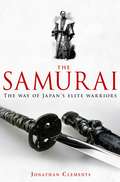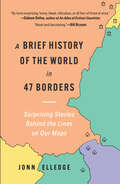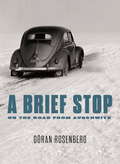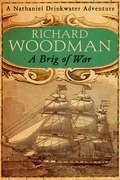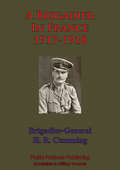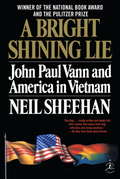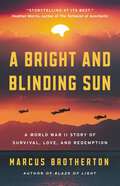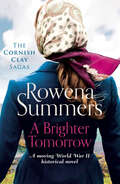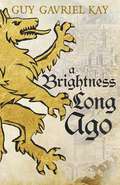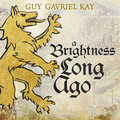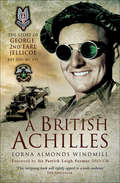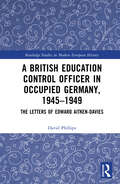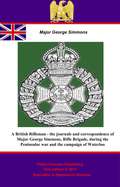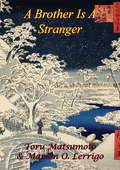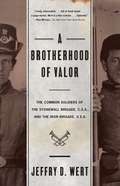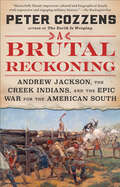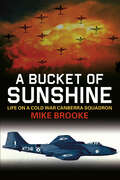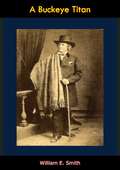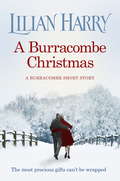- Table View
- List View
A Brief History of the Samurai (Brief Histories)
by Jonathan Clements'Clements has a knack for writing suspenseful sure-footed conflict scenes: His recounting of the Korean invasion led by samurai and daimyo Toyotomi Hideyoshi reads like a thriller. If you're looking for a samurai primer, Clements' guide will keep you on the hook' Japan Times, reviewed as part of an Essential Reading for Japanophiles series From a leading expert in Japanese history, this is one of the first full histories of the art and culture of the Samurai warrior. The Samurai emerged as a warrior caste in Medieval Japan and would have a powerful influence on the history and culture of the country from the next 500 years. Clements also looks at the Samurai wars that tore Japan apart in the 17th and 18th centuries and how the caste was finally demolished in the advent of the mechanized world.
A Brief History of the Samurai: The Way of Japan's Elite Warriors (Brief History )
by Jonathan ClementsFrom a leading expert in Japanese history, this is one of the first full histories of the art and culture of the Samurai warrior. <P><P>The Samurai emerged as a warrior caste in Medieval Japan and would have a powerful influence on the history and culture of the country from the next 500 years. Clements also looks at the Samurai wars that tore Japan apart in the 17th and 18th centuries and how the caste was finally demolished in the advent of the mechanized world.
A Brief History of the World in 47 Borders: Surprising Stories Behind the Lines on Our Maps
by Jonn Elledge#1 International Bestseller Every border tells a surprising story in this uncommonly enlightening history that will change the way you understand the world “A novel and fascinating perspective on world history.”—Bill Bryson, author of A Short History of Nearly Everything Many lines on the map are worth far more than a thousand words, going well beyond merely marking divisions between nations. In this eye-opening investigation into the most remarkable points on the map, a single boundary might, upon closer inspection, reveal eons of history—from epic tales of conquest, treaties, and alliances to intimate, all-too-human stories of love, greed, and folly. Sometimes rooted in physical geography, sometimes entirely arbitrary, none of the lines we know today were inevitable, and all might have looked quite different if not for the intricate interplay of chance and ambition. By listening to the stories these borders have to tell, we can learn how political identities are shaped, why the world’s boundaries look the way they do—and what they tell us about our world and ourselves. From the very first maps in Egypt to the Roman attempts to define the boundaries of civilization, from the profound shift in meaning of the Mason–Dixon line to the secret British-French agreement to carve up the Ottoman Empire during the First World War, and from the dark consequences of Detroit’s city limits to the intriguing reason why landlocked Bolivia still maintains a navy, this is a singular look at human history—told through its most spellbinding border stories.
A Brief Stop On the Road From Auschwitz
by Sarah Death Goran RosenbergThis shattering memoir by a journalist about his father's attempt to survive the aftermath of Auschwitz in a small industrial town in Sweden won the prestigious August PrizeOn August 2, 1947 a young man gets off a train in a small Swedish town to begin his life anew. Having endured the ghetto of Lodz, the death camp at Auschwitz-Birkenau, the slave camps and transports during the final months of Nazi Germany, his final challenge is to survive the survival. In this intelligent and deeply moving book, Göran Rosenberg returns to his own childhood to tell the story of his father: walking at his side, holding his hand, trying to get close to him. It is also the story of the chasm between the world of the child, permeated by the optimism, progress, and collective oblivion of postwar Sweden, and the world of the father, darkened by the long shadows of the past.
A Brig Of War: Number 3 in series (Nathaniel Drinkwater #3)
by Richard WoodmanNathaniel Drinkwater is promoted lieutenant of the brig Hellebore, and routine convoy escort duties end abruptly when Admiral Nelson, pursuing the French fleet to Egypt, sends Hellebore to the Red Sea with an urgent warning to the British squadron there. However, Nelson's apprehensions over French ambitions in the East are more than justified. Edouard Santhonax, Drinkwater's old enemy, is already preparing for a French descent on India. The hunt for this elusive Frenchman and his frigate combine with British naval operations on the flank of Napoleon's Egyptian campaign. The attack on Kosseir spells near-fatal danger for the hero, and Drinkwater is left for dead, with victory over Santhonax a distant hope.
A Brigadier In France – 1917-1918
by Brigadier Hanway Robert Cumming"Great War memoirs of an officer who served on the Western front as a battalion commander (2 DLI) then as commander 91st Brigade, 7th Division. He was dismissed during the Battle of Bullecourt in May 1917 but came back in May 1918 as commander 110th Brigade. Murdered in Ireland in March 1921 while commanding the Kerry BrigadeHanway Robert Cumming was commissioned into the Durham Light Infantry (DLI) in 1889 and saw active service during the South African War. He was in a staff appointment in India in August 1914 and did not arrive in France till June 1915 where he again held staff appointments until August 1916 when he took command of 2nd DLI. In November 1916 he was appointed to command of the 91st Brigade, 7th Division, a post he held till May 1917 when, during the Battle of Bullecourt he was summarily dismissed by the divisional commander (Shoubridge) and went home on leave, under protest as he describes in the book (less than a month later he was awarded the DSO in the 1917 Birthday Honours!). From August 1917 to the following February he commanded the MG Corps Training Centre at Grantham and then, in March 1918 he went back to France to command the 110th Brigade, 21st Division where he stayed to the end of the war. After the war, while commanding the Kerry Brigade in Ireland he was murdered, on 6th March 1921...The greater part of the book deals with his command of the 110th Brigade which he took over less than a week before the German Spring offensive, which is dealt with in detail, as is the May offensive in Champagne in which 21st Division was one of the five British divisions fighting under French command, and then the final allied counter-offensive. In all this is an interesting picture of the life of a brigade commander on the Western front. He tells his story in the third person, referring to himself throughout as the brigadier."--N&M Press Ed.
A Bright Shining Lie: John Paul Vann And America In Vietnam (Picador Bks.)
by Neil SheehanOutspoken and fearless, John Paul Vann arrived in Vietnam in 1962, full of confidence in America's might and right to prevail. A Bright Shining Lie reveals the truth about the war in Vietnam as it unfolded before Vann's eyes: the arrogance and professional corruption of the U.S. military system of the 1960s, the incompetence and venality of the South Vietnamese army, the nightmare of death and destruction that began with the arrival of the American forces. Witnessing the arrogance and self-deception firsthand, Vann put his life and career on the line in an attempt to convince his superiors that the war should be fought another way. But by the time he died in 1972, Vann had embraced the follies he once decried. He went to his grave believing that the war had been won.<P><P> A haunting and critically acclaimed masterpiece, A Bright Shining Lie is a timeless account of the American experience in Vietnam–a work that is epic in scope, piercing in detail, and told with the keen understanding of a journalist who was actually there. Neil Sheehan' s classic serves as a stunning revelation for all who thought they understood the war.<P> Winner of the Pulitzer Prize.<P> Winner of the National Book Award
A Bright and Blinding Sun: A World War II Story of Survival, Love, and Redemption
by Marcus BrothertonFrom a New York Times bestselling author comes the incredible true story of an underage soldier's first love and loss on the battlefields of Bataan and Corregidor—perfect for fans of The Boy Who Followed His Father into Auschwitz and Unbroken. Joe Johnson Jr. ran away from home at the age of 12, hopping a freight train at the height of the Great Depression. He managed to talk his way into the U.S. Army two years later. Seeking freedom and adventure, he was sent to the Philippines. Adrift in spirit, Joe visited a teenage prostitute, and they became unlikely, smitten allies. Yet when the Japanese attacked on December 8, 1941, their hopes of being together had to wait. Joe and his fellow soldiers fought for four brutal months in Bataan and Corregidor, until they were forced to surrender. The boy endured years of horror as a prisoner of war, only dreaming about seeing again the girl he&’d come to love. This lyrically written and deeply encouraging saga will remind you that every life can be lifted, forgiveness is the patron of restoration, and redemption is available to all.
A Brighter Day Tomorrow
by Pamela EvansA BRIGHTER DAY TOMORROW is a heartwarming and poignant saga from Pam Evans, set in London during the Second World War. Perfect for readers of Kitty Neale, Katie Flynn and Dilly Court. Readers love Pam Evans' books: 'A touching novel' Daily ExpressWhen they're not working in a West London munitions factory, Liz Beck and her best friend Marg find time for fun and laughter at the local ice rink. Then a couple of handsome American servicemen sweep them off their feet and Marg's dream of becoming a GI bride looks like it might come true.Liz's sister Dora is jealous of the romance that blossoms between Victor and Liz but nothing can spoil Liz's happiness. Then tragedy strikes and Liz makes a discovery that causes a rift in her family. With almost nothing left to lose, she finds love and support where she least expects it and, as the war comes to an end, she hopes for a brighter day tomorrow...
A Brighter Day Tomorrow
by Pamela EvansA BRIGHTER DAY TOMORROW is a heartwarming and poignant saga from Pam Evans, set in London during the Second World War. Perfect for readers of Kitty Neale, Katie Flynn and Dilly Court. Readers love Pam Evans' books: 'A touching novel' Daily ExpressWhen they're not working in a West London munitions factory, Liz Beck and her best friend Marg find time for fun and laughter at the local ice rink. Then a couple of handsome American servicemen sweep them off their feet and Marg's dream of becoming a GI bride looks like it might come true.Liz's sister Dora is jealous of the romance that blossoms between Victor and Liz but nothing can spoil Liz's happiness. Then tragedy strikes and Liz makes a discovery that causes a rift in her family. With almost nothing left to lose, she finds love and support where she least expects it and, as the war comes to an end, she hopes for a brighter day tomorrow...
A Brighter Day Tomorrow
by Pamela EvansA BRIGHTER DAY TOMORROW is a heartwarming and poignant saga from Pam Evans, set in London during the Second World War. Perfect for readers of Kitty Neale, Katie Flynn and Dilly Court. Readers love Pam Evans' books: 'A touching novel' Daily ExpressDespite air raids and rationing in wartime London, sisters Liz and Dora Beck find time for fun and laughter at the local ice-rink. Then a handsome American serviceman catches their attention, and so begins heartache between the sisters. Dora is increasingly jealous of her sister's blossoming romance with Victor. But when Victor is killed in a bomb attack, Liz makes a shocking discovery that upsets her whole family. Forced out of her home, Liz finds support where she least expects it. And, with almost nothing left to lose, she hopes for a brighter day tomorrow...(P)2018 Headline Publishing Group Ltd
A Brighter Tomorrow (The Cornish Clay Sagas)
by Rowena SummersIn this moving World War II saga, a Cornish woman welcomes four children evacuated from London and ponders her family&’s future. In 1940, the comparative calm is disrupted by the arrival of four evacuees from London. While Skye welcomes the new additions with open arms, the other family members have mixed reactions. As, one by one, friends and family are reported missing or killed, Skye is forced to accept that their Cornish luck may be slipping. But Skye has always shared her grandmother&’s passion of keeping the old family business alive, but as the war drags on, she must decide whether the struggles of her family is worth it for an old woman&’s dream. This finale to the Cornish Clay series is perfect for fans of Rosie Goodwin, Katie Flynn, and Lesley Pearse.
A Brightness Long Ago
by Guy Gavriel Kay'The greatest living author of epic fantasy' - Brandon Sanderson 'The finest in his field' - Tor.com 'Guy Gavriel Kay's A Brightness Long Ago is a masterpiece; perhaps the finest work of one of the world's greatest living storytellers' - Fantasy Book Review ***One of Goodreads' Most Anticipated SFF Books of 2019*** Internationally bestselling author Guy Gavriel Kay's latest work is set in a world evoking early Renaissance Italy, with an extraordinary cast of characters. In a chamber overlooking the nighttime waterways of a maritime city, a man looks back on his youth and the people who shaped his life. Danio Cerra's intelligence won him entry to a renowned school, though he was only the son of a tailor. He took service at the court of a ruling count - and soon learned why that man was known as The Beast. Danio's fate changed the moment he recognized Adria Ripoli as she entered the count's chambers one night - intending to kill. Born to power, Adria had chosen a life of danger - and freedom - instead. Other vivid figures share the story: a healer determined to defy her expected lot; a charming, frivolous son of immense wealth; a religious leader more decadent than devout; and, affecting these lives and many more, two mercenary commanders, whose rivalry puts a world in the balance. Further praise for Guy Gavriel Kay 'Contemporary fiction's finest fantasist' Tor.com 'History and fantasy rarely come together as gracefully or readably as they do in the novels of Guy Gavriel Kay' Washington Post 'One of the (if not the) premiere fantasists of our time' The Financial Times 'Compulsively readable . . . Kay is a global phenomenon . . . a storyteller on the grandest scale' Time Magazine (Canada)
A Brightness Long Ago
by Guy Gavriel KayInternationally bestselling author Guy Gavriel Kay's latest work is set in a world evoking early Renaissance Italy, with an extraordinary cast of characters.In a chamber overlooking the nighttime waterways of a maritime city, a man looks back on his youth and the people who shaped his life. Danio Cerra's intelligence won him entry to a renowned school, though he was only the son of a tailor. He took service at the court of a ruling count - and soon learned why that man was known as The Beast.Danio's fate changed the moment he recognized Adria Ripoli as she entered the count's chambers one night - intending to kill. Born to power, Adria had chosen a life of danger - and freedom - instead.Other vivid figures share the story: a healer determined to defy her expected lot; a charming, frivolous son of immense wealth; a religious leader more decadent than devout; and, affecting these lives and many more, two mercenary commanders, whose rivalry puts a world in the balance. A Brightness Long Ago offers both compelling drama and deeply moving reflections on the nature of memory, the choices we make in life, and the role played by the turning of Fortune's wheel.(P)2019 Hodder & Stoughton LimitedPraise for Guy Gavriel KayPraise for Guy Gavriel Kay 'The greatest living author of epic fantasy' Brandon Sanderson 'Contemporary fiction's finest fantasist' Tor.com 'History and fantasy rarely come together as gracefully or readably as they do in the novels of Guy Gavriel Kay' Washington Post 'One of the (if not the) premiere fantasists of our time' The Financial Times 'Compulsively readable . . . Kay is a global phenomenon . . . a storyteller on the grandest scale' Time Magazine (Canada)(P) 2019 Hodder & Stoughton Ltd
A British Achilles: The Story of George, 2nd Earl Jellicoe KBE DSO MC FRS
by Lorna Almonds Windmill&“Intriguing . . . describes a modest but exceptional man from whom the contemporary soldier, politician, and citizen can learn how to enjoy life (and how not to).&” —The Spectator Son of the victor of Jutland, George Jellicoe has enjoyed power and privilege but never shirked his duty. His war exploits are legendary and, as a founder member of Stirling&’s SAS and first commander of the Special Boat Service, he saw action a-plenty. A brigadier at twenty-six with a DSO and MC, he liberated Athens as the Germans withdrew and saved Greece from a Communist revolution. After the war, Jellicoe joined the Foreign Office and worked with spies Guy Burgess, Kim Philby, and Donald Maclean in Washington and on the Soviet Desk. His political life saw him in the Cabinet of the Heath Government and he is frank with his biographer over the issues and characters of his fellow ministers. Jellicoe&’s Achilles heel is his weakness for, and attraction to, women. His resignation over an involvement with a prostitute was a national scandal, but he is refreshingly honest and devoid of self-justification. He remained an active member of the Lords pursuing a top-level business career. A British Achilles is a superb biography of a major public figure and exemplary wartime soldier.
A British Education Control Officer in Occupied Germany, 1945–1949: The Letters of Edward Aitken-Davies (Routledge Studies in Modern European History)
by David PhillipsEdward Aitken-Davies (1899-1981) served as an Education Control Officer in the British Zone of occupied Germany from the early summer of 1945 until December 1949. He thus experienced the implementation of policy in the Zone from the very beginnings of the occupation until the founding of the Federal Republic of German y in 1949. During the period 1945 to 1947 he wrote weekly letters home to his mother. Those letters, together with the many speeches he gave in Germany during his time as a leading British officer in the Hanover region have not hitherto been available to researchers but can now be made accessible in edited form. The letters are placed in the context of developments in British policy and with explanatory notes on the detail. Taken together, his letters and other documents provide insights into the day-to-day lives of the impressive group of individuals who oversaw the development of education in Germany from post-war chaos to the reform and stability which restored the education system of the country to a pre-eminent status in Europe.
A British Rifleman - the Journals and Correspondence of Major George Simmons, Rifle Brigade, during the Peninsular war and the campaign of Waterloo
by Lt.-Colonel Willoughby Cole Verner Major SimmonsThe journals and correspondence of George Simmons add a further lustre to the excellent memoirs and books that men of the 95th Rifles left of the adventures, hard fought actions and grim experiences of the Peninsular War and the Waterloo Campaign. Simmons was commissioned into the 1st Battalion 95th Rifles, a fellow officer of Sir John Kincaid and Sir Harry Smith both of whom left valuable memoirs of the period. A religious and upright man, although not priggish, he kept a journal of the actions movement and events of his life and sent numerous letters home to his family in Hull. These form the narrative which has been ordered by Lt. Col. Verner to flow in sequence through his time fighting Napoleon’s forces.Simmons, and his brothers who often crop up in the volume, was at the forefront of the fighting engaged in by the Light Brigade and later Light Division. He was wounded a number of times, once so seriously at Waterloo as a result of a musket wound to the chest, that his attendants though he might die. He took part in the battles of Fuentes D’Oñoro, Salamanca, Vittoria, the Nivelle, Orthez and finally Waterloo. The storming of Badajoz, Cuidad Rodrigo are also described in vivid detail missing nothing of the fear, death and mayhem of the attacking troops; to give just one excerpt of the action:- I saw my poor friend Major O'Hare lying dead upon the breach. Two or three musket balls had passed through his breast. A gallant fellow, Sergeant Flemming, was also dead by his side, a man who had always been with him. I called to remembrance poor O'Hare's last words just before he marched off to lead the advance. He shook me by the hand saying, "A Lieutenant-Colonel or cold meat in a few hours." I was now gazing upon his body lying stretched and naked amongst thousands more.An excellent read, contemporaneously written and abounding with interesting details.Author – Major George Simmons [1785-1858]Editor – Lt.-Col Willoughby Cole Verner [1852-1922]
A Broken Land: A Roads to War Novel (Roads to War)
by David DonachieThe second installment in Donachie's sweeping Roads to War series set in the pre-WWII European powder keg1936: Soldier of fortune Cal Jardine travels to Barcelona to help with the athletic games rivalling the Berlin Olympics. But as the first shots of civil war ring out, friendship, love, and political conviction converge to persuade Jardine to once again embroil himself in a foreign war.Discovering that the British athletes attending the games are keen to enlist for the fight, Jardine agrees to train them into a professional force. With old army comrade Vince Castellano and his beautiful interpreter Florencia Gardiola by his side, Jardine leads the athletes through the street battles of Barcelona and on to the fighting in the Catalan countryside. But when murderous betrayal blights his previous fortune, Jardine will go to any lengths to seek suitable revenge . . .
A Broken World: Letters, Diaries and Memories of the Great War
by Sebastian Faulks with Hope WolfA lieutenant writes of digging through bodies that have the consistency of Camembert cheese; a mother sends flower seeds to her son at the Front, hoping that one day someone may see them grow; a nurse tends a man back to health knowing he will be court-martialled and shot as soon as he is fit. Edited by the bestselling author of Birdsong and Dr Hope Wolf, this is an original and illuminating non-fiction anthology of writing on the First World War.Diaries, letters and memories, testaments from ordinary people whose lives were transformed, are set alongside extracts from names that have become synonymous with the war, such as Siegfried Sassoon and T.E. Lawrence. A Broken World is an original collection of personal and defining moments that offer an unprecedented insight into the Great War as it was experienced and as it was remembered.
A Brother Is A Stranger
by Marion O. Lerrigo Toru MatsumotoWe in Japan have a saying, "A brother is the beginning of a stranger," because on the father's death the oldest brother acquires such absolute authority as the head of the family that the younger ones and he cannot easily be friends. After our father died, my eldest brother assumed the dictatorial authority of father, as sanctioned by Japanese law and custom. I wanted to live my own life, and I did; but I had to fight for it against the old Japanese tradition that superiors must benevolently govern their inferiors, and inferiors gratefully obey. I have experienced both bitter sorrows and bursting joys. May the young people of a new Japan obtain the happiness of my wife and myself without the struggle we have been through.--A Word From the Author, Toru Matsumoto
A Brotherhood Of Valor: The Common Soldiers Of The Stonewall Brigade C S A And The Iron Brigade U S A
by Jeffry D. WertThis unusual and moving chronicle covers some of the most important battles of the Civil War—Sharpsburg (Antietam), Gettysburg, and Chancellorsville—through the stories of the two brigades who confronted each other on the bloody fields of battle.Drawing on original source material, Jeffry Wert reconstructs the drama and terrors of war through the eyes of the ordinary men who became members of two of the most respected fighting units of their respective armies, the Stonewall Brigade of the Confederacy and the Iron Brigade of the Union. There are tales of grueling marches and almost unbearable deprivations; eyewitness accounts of ferocious fighting and devastating losses on both sides; and portraits of acts of courage and valor performed by soldiers and officers who, despite the difficulties they faced, remained dedicated to the cause for which they were fighting.
A Brutal Reckoning: Andrew Jackson, the Creek Indians, and the Epic War for the American South
by Peter CozzensThe story of the pivotal struggle between the Creek Indians and an insatiable, young United States for control over the Deep South—from the acclaimed historian and prize-winning author of The Earth is WeepingThe Creek War is one of the most tragic episodes in American history, leading to the greatest loss of Native American life on what is now U.S. soil. What began as a vicious internal conflict among the Creek Indians metastasized like a cancer. The ensuing Creek War of 1813-1814 shattered Native American control of the Deep South and led to the infamous Trail of Tears, in which the government forcibly removed the southeastern Indians from their homeland. The war also gave Andrew Jackson his first combat leadership role, and his newfound popularity after defeating the Creeks would set him on the path to the White House.In A Brutal Reckoning, Peter Cozzens vividly captures the young Jackson, describing a brilliant but harsh military commander with unbridled ambition, a taste for cruelty, and a fraught sense of honor and duty. Jackson would not have won the war without the help of Native American allies, yet he denied their role and even insisted on their displacement, together with all the Indians of the American South in the Trail of Tears.A conflict involving not only white Americans and Native Americans, but also the British and the Spanish, the Creek War opened the Deep South to the Cotton Kingdom, setting the stage for the American Civil War yet to come. No other single Indian conflict had such significant impact on the fate of America—and A Brutal Reckoning is the definitive book on this forgotten chapter in our history.
A Bucket of Sunshine: Life on a Cold War Canberra Squadron
by Mike BrookeA Bucket of Sunshine - a term used for the use of a nuclear bomb - is a firsthand insight into life in the mid-1960s on a RAF Canberra nuclear-armed squadron in West Germany on the frontline in the Cold War. Mike Brookes describes not only the technical aspect of the aircraft and its nuclear and conventional roles and weapons, but also majors on the low-level flying that went with the job of being ready to go to war at less than three minutes notice. Brooke tells his story warts and all, with many amusing overtones, in what was an extremely serious business when the world was standing on the brink of nuclear conflict. The English-Electric Canberra was a first-generation jet-powered light bomber manufactured in large numbers in the 1950s. The Canberra could fly at a higher altitude than any other bomber through the 1950s and set a world altitude record of 70,310 feet. Due to its ability to evade early interceptors and providing a significant performance advancement over piston-engine bombers, the Canberra was a popular export product and served with many nations. Although jet powered, the Canberra design philosophy was very much in the Mosquito mould, providing room for a substantial bomb load, fitting two of the most powerful engines available, and wrapping it in the most compant and aerodynamic package possible. Rather than devote space and weight to defensive armament, the Canberra was designed to fly fast and high enough to avoid air-to-air combat entirely.
A Buckeye Titan
by William E. SmithHere is a panorama of life as it was lived and witnessed by one Ohio citizen, his family, and his friends, from 1816-1876. From the diary and correspondence of John H. James of Urbana, Ohio, and from contemporary manuscripts, periodicals, and newspapers, William E. and Ophia D. Smith have created an authentic picture of the times. A Buckeye Titan is not so much a biography of a man as it is an exposition of the contribution of his manuscripts to American history in general and to Ohio history in particular. The point of view presented is that of the protagonist and his friends.Cincinnati and Louisville are seen when slow-moving, square-rigged barges and primate boats propelled by “elastic vigor” crowded their landings, and when stately floating castles received and discharged passengers and cargoes upon their busy rivers. Lexington, Athens of the West, is portrayed as it was in the lush days of Horace Holley. The sophistication of New Orleans, Philadelphia, and New York sets off the awkward adolescence of such Mid-Western towns as Columbus, Dayton, Urbana, and Indianapolis. Against a background of devious politics and frenzied finance, the Mad River and Lake Erie Rail Road begins in Sandusky and stubbornly fights its way to Springfield. Whigs and Loco Focos engage in a titanic struggle of the establishment of a second banking system.Civil War days are graphically drawn. The tumultuous conflict of opinion, the graft and corruption, the political chicanery in the raising of troops and in the promotion of officers and men, the strength and the weakness of the Northern fighting forces and their leaders—all are here.Statesmen and politicians, reformers and scholars, authors and artists, actors and actresses, soldiers, travelers, bankers and merchants, founders of the first Swedenborgian college in the world, and plain everyday people, as well as intimate glimpses of distinguished characters, appear in these pages.
A Burracombe Christmas
by Lilian HarryA short story to whisk you away on a festive trip to the Devonshire village where life is full of surprisesSteal a glimpse at the past lives and loves of your favourite villagers in this captivating Burracombe short story. Autumn 1918 has brought young Alice Whiddon to the Tozer's farm to work as a maid. Alice soon falls in love with the little village and with life on the farm. But that's not all she's falling for. Youngest son, Ted Tozer is half promised to young Ivy Prowse, daughter of a neighbouring farmer, yet Alice and Ted feel a powerful bond forming.But while the first peacetime Christmas in years beckons, romance must wait as influenza comes to the farm and threatens to bring tragedy with it, just as the Tozer's eldest son Joe returns from the front to Burracombe and his sweetheart, Dottie. As Alice and the family wait and hope for the new year to bring long-awaited joy and peace, no one knows whether the bells will peal in sorrow or in celebration as the year turns.
